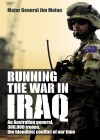Running the War in Iraq: An Australian general, 300,000 troops, the bloodiest conflict of our time
Written by: Jim Molan,
HarperCollins Publishers, Sydney, 2008,
ISBN: 9780732287818, 358 pp.
Reviewed by: Albert Palazzo
Major General Jim Molan has written a compelling, riveting, and fast paced memoir of his year in Iraq as a senior officer with the Headquarters Multi-National Force – Iraq. Molan’s primary position was Chief of Operations to the US Commander, General George G Casey, although he also played an important role in safeguarding Iraq’s infrastructure and organising the nation’s first free election. From April 2004 to April 2005 Molan was a central figure in the war, an Australian soldier taken into the inner circle of the US war effort.
While it is a memoir, Running the War in Iraq rises above the level of a personal snapshot of a conflict viewed through one man’s experiences. Instead, this is a sweeping story that delves into the essentials of modern generalship. For most of the Australian Army’s history its leaders have excelled at the tactical level, but few of its commanders have had first hand experience in the art of operations. Molan thought at the theatre level, and had to balance resources and opportunity with the ever present need to move towards a strategic goal. At the same time he had to assess every proposed operation, making sure that coalition troops acted within correct legal and moral boundaries. This was a rare responsibility for an Australian general.
Molan also brings home the complexity of modern counterinsurgency. In recent literature much has been made by military professionals and thinkers of General Charles Krulak’s ‘three-block war’ concept. While the Australian Army has considerable experience in counterinsurgency, the reality is that since the end of the Vietnam War most of the institution has operated only on Krulak’s less dangerous ‘blocks’: humanitarian relief and peacekeeping. One of the lessons of this book is that even in an unconventional war the ‘third block’ can be an extremely dangerous and unforgiving sector, whose intensity rivals that of a state-on-state conflict. Consequently, if friendly troops are to succeed they must have the ability, both in education, training and equipment, to bring to bear the full arsenal of modern war. Molan had first-hand experience with this fact as he and his staff planned and then watched unfold the second Battle of Fallujah. For Australia, Molan’s lesson is that it is the enemy who decides the intensity of unconventional war, and that the Army must improve its ability to wage violent battle if it is to meet the challenge when it arrives.
The book does have some weaknesses, but they do not overly detract from its value. At times Molan appears slightly in awe of his US colleagues, but perhaps this is only a result of the depth of his acceptance, the access he was provided, and the real responsibilities he was given. The book could also have been shortened by the deletion of the chapter on Molan’s back-story. Military professionals will find this book a rewarding read, while for the public Running the War in Iraq offers what is still far too rare an insight into Australia’s role in the Iraq War.


